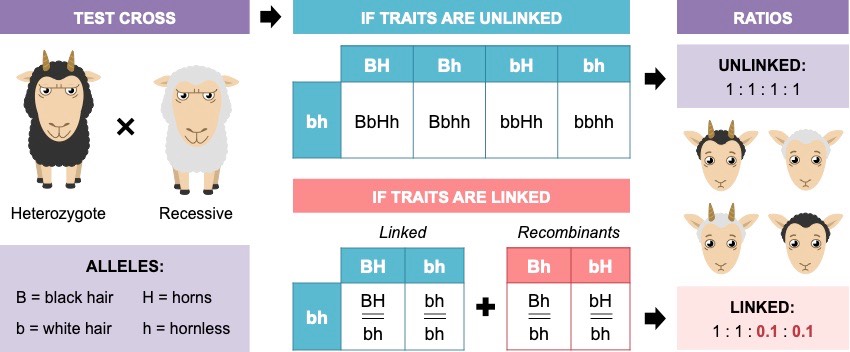Key Knowledge:
|
Two genes will be inherited independently of one another if their loci are on separate chromosomes (these genes are said to be unlinked)
- The alleles for unlinked genes can occur in any potential combination due to the random assortment of chromosomes in metaphase I
- This results in a greater variety of possible phenotypes, leading to more complex inheritance patterns
Dihybrid Cross
A dihybrid cross determines the genotypic and phenotypic combinations of offspring for two particular genes that are unlinked
- Because there are two genes, each with two alleles, there can be up to four different gamete combinations (calculated using FOIL)

The inheritance of dihybrid traits can be calculated according to the following steps:
- Step 1: Designate characters to represent the alleles (capital letter for dominant allele, lower case letter for recessive allele)
- Step 2: Write down the parental genotype and phenotype (always pair alleles from the same gene – i.e. AaBb not ABab)
- Step 3: Write down all potential gamete combinations for both parents (use the FOIL method to identify all combinations)
- Step 4: Use a Punnett square to work out potential genotypes (only include different combinations – i.e. AaBB = AB and aB)
- Step 5: Write out the phenotype ratios of potential offspring (only reflects probabilities not actual offspring ratios)

Linked Genes
A linkage group is a group of genes whose loci are on the same chromosome and hence don’t independently assort
- Linked genes will tend to be inherited together and hence don’t follow normal Mendelian inheritance for a dihybrid cross
- Instead the phenotypic ratio will be more closely aligned to a monohybrid cross as the two genes are inherited as a single unit
- Linked genes may become separated via recombination (due to crossing over during synapsis in meiosis I)

Because linked genes are on the same chromosome, they do not follow the expected ratios of a dihybrid cross
- Offspring should only inherit to phenotypic combinations seen in the parents for the two traits – unless crossing over occurs
- Crossing over (in meiosis) can separate linked genes to form recombinant phenotypes (the combinations not seen in the parents)
- Because recombination is an uncommon event, the recombinant phenotypes will be inherited at a significantly lower frequency
By performing a test
cross, the relationship between two genes (linked versus unlinked) can be determined
- If the outcome of a test cross mirrors what is predicted by a dihybrid cross, then the two genes can be considered unlinked
- If the outcome of a test cross does not conform to what is predicted via a dihybrid cross, then this suggests the genes are linked
- The phenotypes that are occurring in lower amounts likely reflect the recombinant phenotypes
